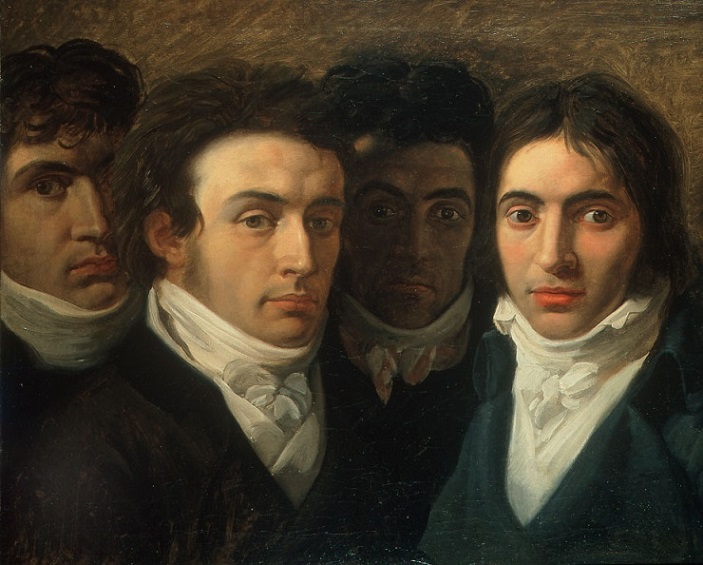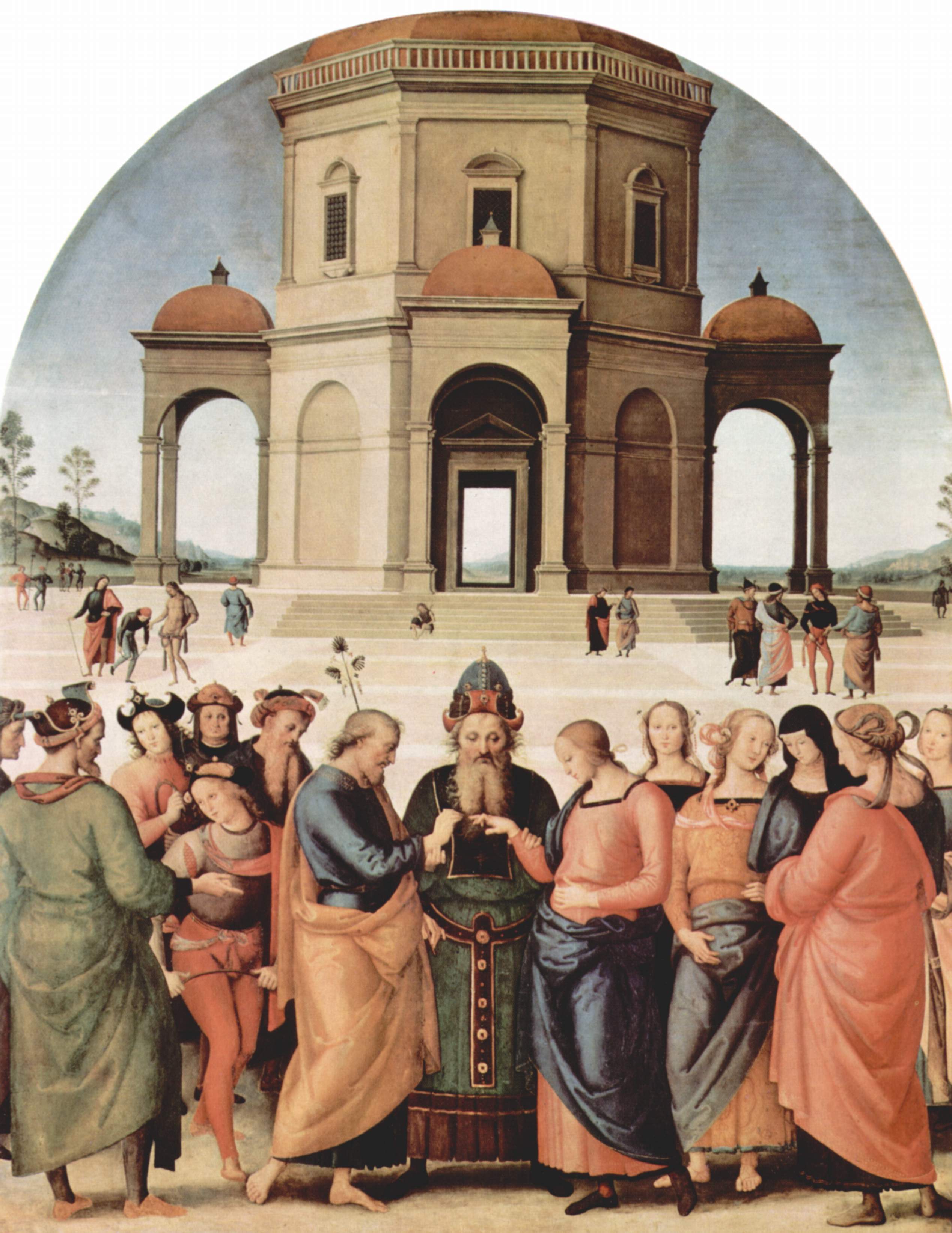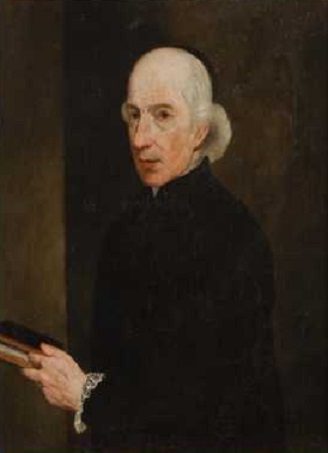|
Giuseppe Bossi
Giuseppe Bossi (11 August 1777 – 9 November 1815) was an Italian painter, arts administrator and writer on art. He ranks among the foremost figures of Neoclassical culture in Lombardy, along with Ugo Foscolo, Giuseppe Parini, Andrea Appiani or Manzoni. Biography Early life and education Giuseppe Bossi was born in the town of Busto Arsizio, near Milan. He was educated at the college of Monza; and his early fondness for drawing was fostered by the director of the college. He then studied at the Brera Academy of Fine Arts at Milan, and spent the years 1795 to 1801 in Rome, where he drew Roman remains and honed his skills in drawing anatomy at the morgue of a hospital and formed an intimate friendship with Antonio Canova, Canova, who made a portrait bust of Bossi. In Rome, Bossi acquainted himself with such Neoclassical artists as Angelica Kauffman and Marianna Candidi Dionigi as well as writers, scholars and archaeologists, notably Jean Baptiste Seroux d'Agincourt, Giovann ... [...More Info...] [...Related Items...] OR: [Wikipedia] [Google] [Baidu] |
Camillo Pacetti
Camillo Pacetti (Rome, 2 May 1758 - Milan, 16 July 1826) was an Italian sculptor. He was the brother of Vincenzo Pacetti, another sculptor. A student of the Accademia di San Luca, he later worked in various churches in Rome and Milan. In 1804, on Antonio Canova's recommendation, he was offered the role of chair of the Accademia di Belle Arti di Brera in Milan, to succeed Giuseppe Franchi. Besides this teaching engagement, Pacetti accepted also public commissions, such as the statue of the New Law for the facade of the Milan Cathedral, Duomo and reliefs for the Arco della Pace, Milan, Arco della Pace at Milan (the arch planned by Luigi Cagnola and also featuring sculpture by Luigi Canonica). His subject matter ranged from portraits to mythological and allegorical scenes. He was engaged by Josiah Wedgwood in Rome from 1787/88 under the supervision of John Flaxman, to model six tablets illustrating the life of Achilles. A pen and wash drawing by Pacetti of Achilles on the back ... [...More Info...] [...Related Items...] OR: [Wikipedia] [Google] [Baidu] |
Jean Baptiste Seroux D'Agincourt
Jean Baptiste Louis George Seroux D'Agincourt (5 April 1730 – 24 September 1814) was a French archaeologist and historian. Born in Beauvais, he was a descendant of the counts of Namur, and in his youth he served as an officer in a regiment of cavalry. Finding it necessary to quit the army in order to take charge of his younger brothers who had been left orphans, he was appointed a farmer-general by Louis XV. In 1777 he visited England, Germany and the Dutch Republic The United Provinces of the Netherlands, commonly referred to in historiography as the Dutch Republic, was a confederation that existed from 1579 until the Batavian Revolution in 1795. It was a predecessor state of the present-day Netherlands ...; and in the following year he travelled through Italy, with the view of exploring thoroughly the remains of ancient art. He afterwards settled in Rome and devoted himself to preparing the results of his researches for publication. He died in 1814, leaving the work, wh ... [...More Info...] [...Related Items...] OR: [Wikipedia] [Google] [Baidu] |
Consulte De Lyon
The Consulte de Lyon (consulta of Lyon) or consulte de la république cisalpine (consulta of the Cisalpine Republic) was an extraordinary meeting in the former chapel of the Jesuit college of the Trinity in Lyon during the French Consulate. It was held from 11–26 January 1802 and converted the Cisalpine Republic into the Italian Republic, with Napoleon Bonaparte as its president. Course As first consul, Bonaparte decided to call an extraordinary ''consulta'' or meeting of the Italian deputies of the Cisalpine Republic in Lyon. This republic had been created after the first Italian campaign and was made up of Lombardy, Mantua, Bergamo, Brescia, Verona, Cremona, Rovigo, the duchy of Modena, Massa, and Carrara, and three legations from Bologna, Ferrara, and Romagna. The proposal for the meeting was highly successful - 452 deputies were named to attend it, though it was effectively a parody of a constituent assembly, with its members vetted by Bonaparte, an order of business impos ... [...More Info...] [...Related Items...] OR: [Wikipedia] [Google] [Baidu] |
Giovanni Bellini
Giovanni Bellini (; c. 1430 – 29 November 1516) was an Italian Renaissance painter, probably the best known of the Bellini family of Venetian painters. He was raised in the household of Jacopo Bellini, formerly thought to have been his father, but now that familial generational relationship is questioned.; An older brother, Gentile Bellini was more highly regarded than Giovanni during his lifetime, but the reverse is true today. His brother-in-law was Andrea Mantegna. Giovanni Bellini was considered to have revolutionized Venetian painting, moving it toward a more sensuous and colouristic style. Through the use of clear, slow-drying oil paints, Giovanni created deep, rich tints and detailed shadings. His sumptuous colouring and fluent, atmospheric landscapes had a great effect on the Venetian painting school, especially on his pupils Giorgione and Titian. The Bellini (cocktail), Bellini cocktail is named in his honour. Life Early career Giovanni Bellini was born in Veni ... [...More Info...] [...Related Items...] OR: [Wikipedia] [Google] [Baidu] |
The Marriage Of The Virgin (Raphael)
''The Marriage of the Virgin'', also known as ''Lo Sposalizio'', is an oil painting by the Italian High Renaissance artist Raphael. Completed in 1504 for the Franciscan church of San Francesco, Città di Castello, the painting depicts a marriage ceremony between Mary and Joseph. It changed hands several times before settling in 1806 at the Pinacoteca di Brera. History In the later years of the 15th century, patrons in Citta di Castello sent three commissions to Raphael's teacher Pietro Perugino which, in Perugino's absence, were completed by Raphael.McCurdy (1917), p. 84. ''The Marriage of the Virgin'', featuring the theme of the Marriage of the Virgin, was the last of these. Evidently inspired by one of Perugino's paintings, also known as '' Marriage of the Virgin'', Raphael finished his own work, according to the date placed next to his signature, in 1504.Champlin and Perkins (1913), p. 380. This particular work was commissioned by Filippo degli Albezzini for his family's s ... [...More Info...] [...Related Items...] OR: [Wikipedia] [Google] [Baidu] |
Pinacoteca Di Brera
The Pinacoteca di Brera ("Brera Art Gallery") is the main public gallery for paintings in Milan, Italy. It contains one of the foremost collections of Italian paintings from the 13th to the 20th century, an outgrowth of the cultural program of the Brera Academy, which shares the site in the Palazzo Brera. History The Palazzo Brera owes its name to the Germanic ''braida'', indicating a grassy opening in the city structure: compare the ''Bra'' of Verona. The convent on the site passed to the Jesuits (1572), then underwent a radical rebuilding by Francesco Maria Richini (1627–28). When the Jesuits were disbanded in 1773, the palazzo remained the seat of the astronomical Observatory and the Braidense National Library founded by the Jesuits. In 1774 the herbarium of the new botanical garden was added. The buildings were extended to designs by Giuseppe Piermarini, who was appointed professor in the Academy when it was formally founded in 1776, with Giuseppe Parini as dean. ... [...More Info...] [...Related Items...] OR: [Wikipedia] [Google] [Baidu] |
Carlo Porta
Carlo Porta (15 June 17755 January 1821) was an Italian poet, the most famous writer in Milanese (the prestige dialect of the Lombard language). Biography Early life and education Carlo Porta was born in Milan to a well-to-do family. His father, Giuseppe, was a civil servant for the Habsburg administration. He studied in Monza until 1792 and then in the Seminary of Milan. In 1796, the Napoleonic Wars pushed Porta to find a job in Venice (where one of his brothers lived) and he remained there until 1799. For a brief interlude (1800–4) he was a comic actor at the Teatro Patriottico of Milan. From 1804 until his death, Porta worked as government employee. He was a leading member of Milanese intellectual circles. In 1816 he opened his own ''cameretta'', a gathering of Progressivism, progressive friends, including Alessandro Manzoni, Manzoni, Tommaso Grossi, Grossi, Giovanni Berchet, Berchet and other Romantics, who met once a week to discuss political and literary matters. It wa ... [...More Info...] [...Related Items...] OR: [Wikipedia] [Google] [Baidu] |
Bossi Cattaneo Porta Taverna
Bossi may refer to: * Bossi (surname) * Bossi (organ builders), an Italian organ builders * Betty Bossi, a Swiss cookbook publisher * , an ice hockey tournament named for Luciano Bossi * Stefan Bossems of Cosmic Gate Cosmic Gate is a German DJ duo consisting of trance music producers Claus Terhoeven (born 1972) and Stefan Bossems (born 1967). Both hail from Krefeld, Germany. On October 28, 2009, ''DJ Magazine'' announced the results of their annual Top 100 ..., a German musician with the pseudonym "DJ Bossi" * Dario Bossi, a fictional character from the video game series Castlevania See also * Bosse (other) {{disambiguation ... [...More Info...] [...Related Items...] OR: [Wikipedia] [Google] [Baidu] |
Domenico Conti Bazzani
Domenico Maria Conti or Conti Bazzani (or Bazzano/Bozani) (Mantua, 1740 - Rome, 19 February 1815) was an Italian painter, bridging Rococo and Neoclassical styles. He is described as a disciple, and adoptive son of Giuseppe Bazzani, who was director of the Academy of Mantua after 1767. History He studied in the Academy of Mantua under Bazzani, and was awarded gold medals in competitions in 1765 and 1766. In 1769, his essay on a young ''Scipio Africanus'' was also awarded gold medals, but he did not accept a title of master, but a position teaching figure painting. Among his works in Mantua, he painted in the Royal Palace and in the church of San Zenone. The ''Jesus Nazarene'' in the Cathedral was painted during his stay in Rome. In 1770, Conti moved to Rome, where he found papal patronage, trained with Pompeo Batoni, and was able to establish an active studio. Among his pupils were Giuseppe Tominz and Giuseppe Bossi. It is reputed that Vincenzo Camuccini and Pietro Benvenuti ... [...More Info...] [...Related Items...] OR: [Wikipedia] [Google] [Baidu] |
Michelangelo
Michelangelo di Lodovico Buonarroti Simoni (6March 147518February 1564), known mononymously as Michelangelo, was an Italian sculptor, painter, architect, and poet of the High Renaissance. Born in the Republic of Florence, his work was inspired by models from classical antiquity and had a lasting influence on Western art. Michelangelo's creative abilities and mastery in a range of artistic arenas define him as an archetypal Renaissance man, along with his rival and elder contemporary, Leonardo da Vinci. Given the sheer volume of surviving correspondence, sketches, and reminiscences, Michelangelo is one of the best-documented artists of the 16th century. He was lauded by contemporary biographers as the most accomplished artist of his era. Michelangelo achieved fame early. Two of his best-known works, the ''Pietà (Michelangelo), Pietà'' and ''David (Michelangelo), David'', were sculpted before the age of 30. Although he did not consider himself a painter, Michelangelo created ... [...More Info...] [...Related Items...] OR: [Wikipedia] [Google] [Baidu] |
Raphael
Raffaello Sanzio da Urbino (; March 28 or April 6, 1483April 6, 1520), now generally known in English as Raphael ( , ), was an Italian painter and architect of the High Renaissance. List of paintings by Raphael, His work is admired for its clarity of form, ease of composition, and visual achievement of the Platonism in the Renaissance, Neoplatonic ideal of human grandeur. Together with Leonardo da Vinci and Michelangelo, he forms the traditional trinity of great masters of that period. His father Giovanni Santi was court painter to the ruler of the small but highly cultured city of Urbino. He died when Raphael was eleven, and Raphael seems to have played a role in managing the family workshop from this point. He probably trained in the workshop of Pietro Perugino, and was described as a fully trained "master" by 1500. He worked in or for several cities in north Italy until in 1508 he moved to Rome at the invitation of Pope Julius II, to work on the Apostolic Palace at Vatican ... [...More Info...] [...Related Items...] OR: [Wikipedia] [Google] [Baidu] |
Museo Pio-Clementino
The Vatican Museums (; ) are the public museums of the Vatican City. They display works from the immense collection amassed by the Catholic Church and the papacy throughout the centuries, including several of the best-known Roman sculptures and most important masterpieces of Renaissance art in the world. The museums contain roughly 70,000 works, of which 20,000 are on display, and currently employs 640 people who work in 40 different administrative, scholarly, and restoration departments. Pope Julius II founded the museums in the early 16th century. The Sistine Chapel, with its ceiling and altar wall decorated by Michelangelo, and the Stanze di Raffaello (decorated by Raphael) are on the visitor route through the Vatican Museums, considered among the most canonical and distinctive works of Western and European art. In 2024, the Vatican Museums were visited by 6.8 million people. They ranked second in the list of most-visited art museums and museums in the world after the Lou ... [...More Info...] [...Related Items...] OR: [Wikipedia] [Google] [Baidu] |







